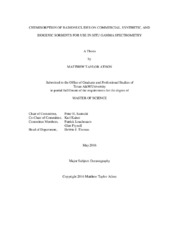| dc.description.abstract | Recent nuclear disasters, such as in Fukushima, Japan, have made it evident that there is a need for the capability to efficiently measure radionuclides in-situ in marine and coastal waters. A group at Pacific Northwest National Laboratory (PNNL) is working to develop a novel, in-situ gamma spectrometer that will provide high resolution gamma spectrometry in natural waters after nuclear disasters. This system will utilize high-capacity chemisorbent cartridges that will pre-concentrate radionuclides from water for lower background and more precise gamma measurement using onboard LaBr3 detectors. Although impregnated MnO2 chemisorbents have been tested for this system previously, there is a demand for improved performance from novel chemisorbents.
In this study, I investigated the particle-water distribution coefficient, KD, of commercial potassium hexacyanoferrate, Anfezh, and three novel MnO2 sorbents using small batch experiments and a set a radionuclides (^7Be, ^57Co, ^106Ru, ^125Sb, ^133Ba, ^137Cs, ^210Pb, ^233Pa, and ^234Th). Results are compared to conventional impregnated MnO2 to determine if these novel materials display superior sorption of radionuclides from solution. A novel nanostructured MnO2 sorbent demonstrated KD performance up to two orders of magnitude greater than traditional impregnated MnO2. Additionally, biogenic MnO2 displayed KD values that were comparable to those of impregnated MnO2 for most radionuclides and are found naturally at the Savannah River Site. Biogenic MnO2 are not expected to be used in the in-situ gamma spectrometer, however this is the first study to evaluate their ability to sorb radionuclides. The results of these tests also determined the shelf life of impregnated MnO2 to be greater than 5 years for most radionuclides tested in synthetic seawater.
I developed a reproducible method for extraction of radiocesium (~80% extraction) from Anfezh after aqueous deployment by mixing Anfezh with NaOH and EDTA inside of a sorbent canister. The results from this work will be applied to future development of PNNL’s gamma spectrometer and marine radiochemical research. | en |


